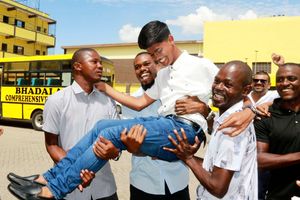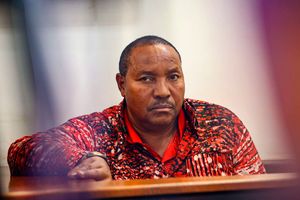Premium
Unfulfilled dreams and a constant battle against poverty: the Joram Roy story
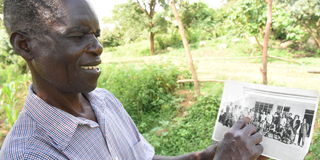
Former football player Joram Roy goes through his past photos at his Navakholo home in Kakamega County.
What you need to know:
- He remembers vividly the day he broke his hand in November 1970 during a chaotic match pitting Harambee Stars against Ethiopia in Addis Ababa.
When former Harambee Stars defender Joram Roy speaks, you have to listen. As one of the three surviving members of the 1972 squad that qualified for the Africa Cup of Nations for the first time, he has seen it all.
"This scar reminds me of how I gave my all to the country on the pitch yet I’m living in abject poverty," he tells me as we settle for an interview at his home at Namakoya village, Navakholo Constituency, Kakamega County.
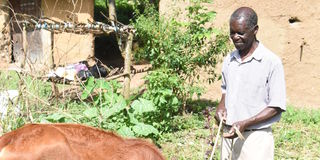
Former football player Joram Roy looks after his cow at his Navakholo home in Kakamega County.
One of Kenya’s unsung heroes of the late 1960s and early 70s, Roy played with the likes of Joe Kadenge, Allan Thigo and James Siang'a – who are considered some of the finest footballers the country has ever produced.
Others members from the 1972 team who are still alive are Thigo and former Kenya Breweries star John Nyawanga. The football fraternity lost Maurice Ouma 'Ogwanjo', who was also part of the 1972 Afcon squad in June.
The 61-year-old was a solid right back in his heyday and featured for the Stars for over five years, before retiring.
He remembers vividly the day he broke his hand in November 1970 during a chaotic match pitting Harambee Stars against Ethiopia in Addis Ababa.
“This scar reminds me of that day. I had never felt so much pain before,” he narrates, his voice fading, as if he is trying to find the right words to describe the situation.
"I have been neglected for many years and I don't think even our leaders in this country know that I exist. I can't walk properly but I have to strive to put food on the table for my family.”
“My mother is partially blind and I have to take care of her too. Things have not been easy.”
Roy recalls how some of his neighbours mocked him after retiring from football-related activities in 1997.
“They kept reminding me that I have nothing despite having played football in the highest level in this country.”
"Should they (government) wait till I die so that they can give me a befitting funeral like the late Joe Kadenge? I plead with the government to come to my rescue, I am growing old and don't have the strength to fend for myself anymore."
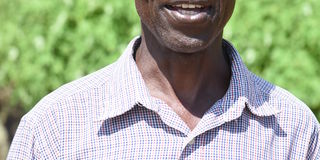
Former football player Joram Roy at his Navakholo home in Kakamega County.
His star started rising when he joined a star-studded Nakuru All Stars side that had football legends Sammy Nyongesa, Peter Ouma 'Pele', Sammy Wamutati while he was still in school.
In 1969, Roy was among players who led Nakuru All Stars to their second league title.
AFC Leopards, Kericho Stars, Kisumu Hot Stars, Gor Mahia and All Stars were paired in a mini-league to determine the winner that season after wrangles emerged towards the end of the season.
Nakuru All Stars ended up winning the league after beating Gor Mahia 3-2 in the final. The team would later represent the country in the Caf inter-club competition the following year but were edged-out by Tanzanian giants Young Africans on a 3-1 aggregate in the opening rounds.
In the final against Gor Mahia, Harambee Stars German coach Eckard Krautzun, who was only 30 years old, was in attendance. It is in this game that Krautzun scouted him.
In 1970, Roy left All Stars and joined the now defunct Bata Bullets in Limuru where he earned his first call up to the national team and featured for the Harambee Stars in the Afcon qualifiers against Ethiopia.
It is in this game that he broke his left hand after irate Ethiopians fans invaded the pitch after the legendary Jonathan Niva stepped up to take a penalty when John Nyawanga was fouled in the box.
"We had won the first leg 2-0 in Nairobi and the Ethiopians were determined exact revenge. However, hell broke loose when Nyawanga was fouled and Niva was just about to take the resulting penalty.”
"We were rescued by the military and a contingent of police officers, I was hit by a metal on my left hand. It was a horrible experience."
Ethiopia was banned from football by Caf after the incident that Roy says left James Siang'a and Paul Ndula distressed.

Former football player Joram Roy goes through his past photos at his Navakholo home in Kakamega County.
Roy would also play all matches in the 1972 Cup of Nations which consisted of only eight teams.
Kenya lost its first match against Cameroon 2-1, before settling for a 1-1 draw against Mali and Togo in the competition.
He went on to feature for the national team until 1975 before he was dropped and continued to play for Bata Bullets until 1981 when he hanged up his boots.
He later travelled to Germany for a coaching course and returned to the country to coach Mumias Sugar in 1983. The former Western region giants would gain promotion to the Kenyan Premier League in 1984 under Roy, after missing out in 1983 in a controversial manner.
In 1991, he left Mumias Sugar for Nzoia Sugar where he worked until 1996 then joined Mbale Heroes as a coach in 1997.
“I left Mbale Heroes because they didn't pay me for a year. That is when I decided to quit coaching and football related activities to concentrate on farming to feed my family."
The former Harambee Stars defender now calls on the government to look into the plight of yesteryear footballers who are suffering and can't manage to fend for themselves.
"We should be celebrated in life not after we die because we played a great role and we were patriotic. Football was not paying those days and if it was, some of us would have invested and would be enjoying the proceeds of our sweat."



